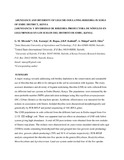| dc.contributor.author | G. M, Mwenda | |
| dc.contributor.author | N.K, Karanja | |
| dc.contributor.author | H., Boga | |
| dc.contributor.author | J.H.P, Kahindi | |
| dc.contributor.author | A, Muigai | |
| dc.contributor.author | D, Odee | |
| dc.date.accessioned | 2013-02-27T13:24:39Z | |
| dc.date.issued | 2011 | |
| dc.identifier.citation | Tropical and Subtropical Agroecosystems, 13 (2011): 1 - 10 | en |
| dc.identifier.uri | http://erepository.uonbi.ac.ke:8080/xmlui/handle/123456789/12120 | |
| dc.description.abstract | A major strategy towards addressing soil fertility depletion is the conservation and sustainable use of rhizobia that are able to fix nitrogen in the soil in association with legumes. The study assessed abundance and diversity of legume nodulating rhizobia (LNB) in soils collected from six different land use systems in Embu District, Kenya. The populations were estimated by the most-probable-number (MPN) plant infection technique using Macroptilium atropurpureum (DC.) Urban (Siratro) as the trap host species. Symbiotic effectiveness was measured for the isolates in association with Siratro. Isolated rhizobia were characterized morphologically and genetically by PCR-RFLP and partial sequencing of 16S rRNA genes.
The LNB populations in soils collected from the different land uses in Embu ranged from 0 to 2.3 102 cells g-1 soil. There was apparent land use effect on abundance of LNB with fallow system giving high abundance. A total of 250 pure isolates were obtained from the root nodules of Siratro trap plants. The isolates were characterized on yeast extract mannitol mineral salts agar (YEMA) media containing bromothymol blue and grouped into fast growers (acid-producing) and slow growers (alkali-producing) (70% and 30 % of isolates respectively). PCR-RFLP analysis categorised the rhizobia into five species in the genera Rhizobium, Bradyrhizobium, Mesorhizobium and Agrobacterium. Land use system under tea had four of the five species found in the area whereas natural forests had two species. Land use significantly impacted on the diversity of rhizobia (P<0.05) with soils under tea having the highest diversity with a mean Shannon diversity index of 1.304 compared to the lowest (0.297) recorded in natural forest. Isolated rhizobia strains formed effective nodules on Siratro. However, the level of nitrogen fixation varied among isolates while the symbiotic efficiency ranged from 27- 112%.
The findings indicate that abundance and diversity of rhizobia does not necessarily decrease with agricultural intensification as hypothesized but recommends further studies to obtain a clearer understanding of the relationship between soil rhizobia diversity and land use and management.
Key words: Rhizobia; most-probable-number (MPN); trap host; Macroptilium atropurpureum (Siratro); symbiotic efficiency. | en |
| dc.language.iso | en | en |
| dc.subject | Rhizobia | en |
| dc.subject | Most-probable-number (MPN | en |
| dc.subject | Trap host | en |
| dc.subject | Macroptilium atropurpureum (Siratro); | en |
| dc.subject | Symbiotic efficiency | en |
| dc.title | Abundance and Diversity of Legume Nodulating Rhizobia in Soils of Embu District, Kenya | en |
| dc.type | Article | en |
| local.embargo.terms | 6 months | en |
| local.publisher | Jomo Kenyatta University of Agriculture and Technology | en |
| local.publisher | United States International University | en |
| local.publisher | Kenya Forestry Research Institute | en |
| local.publisher | Department of Land Resource Management & Agricultural Technology, University of Nairobi, Kenya | en |

